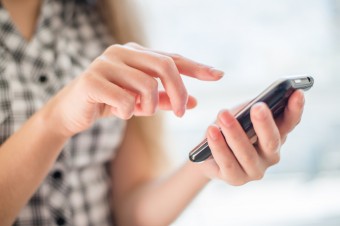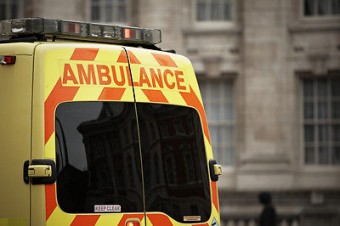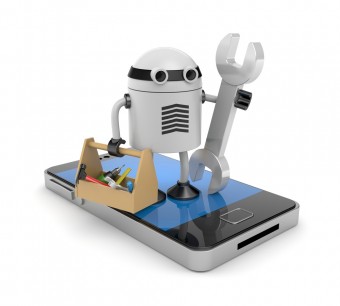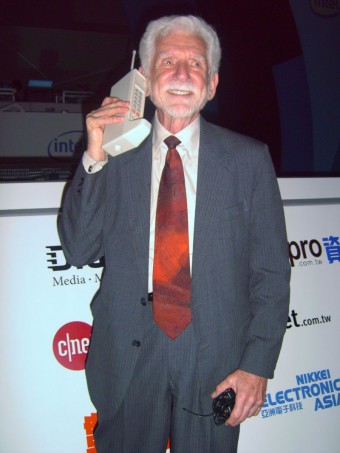15 Fascinating Cell Phone Related Facts You Probably Didn’t Know
1) The Name: “Cellular phones,” or more common today “cell phones,” get their name from the fact that areas served by towers are divided up into “cells.” The first use of the word “cellular” in this fashion was in 1977. The first documented use of the word “cell phone” was in 1984.
2) The First: On April 3, 1973, a Motorola employee, Martin Cooper, publicly demonstrated the world’s first handheld mobile phone by placing a call to Joel Engel, the head of research at AT&T’s Bell Labs using the phone. Engel and his team were Cooper’s chief rival and had also been attempting to make the world’s first handheld mobile phone. As Cooper stated, “As I walked down the street while talking on the phone, sophisticated New Yorkers gaped at the sight of someone actually moving around while making a phone call. Remember that in 1973, there weren’t cordless telephones, let alone cellular phones. I made numerous calls, including one where I crossed the street while talking to a New York radio reporter – probably one of the more dangerous things I have ever done in my life.”
3) The Phone: This first handheld cell phone weighed 2.4 pounds and was 9 x 5 x 1.75 inches in size. For reference, the iPhone 6 is 5.44 x 2.64 x 0.27 inches and weighs just 129 grams (0.28 pounds) This first handheld cell phone also had only 20 minutes of battery life when talking, but as Martin Cooper stated “that wasn’t really a big problem because you couldn’t hold that phone up for that long.” Once the phone battery was drained, it took approximately 10 hours to charge back up fully.
4) The Fanboys: Although Apple’s iPhones generally receive the most hype and publicity, world-wide approximately 88.3% of all mobile phones in use today are not iPhones. Further, Android is king by far in terms of OS used on smart phones with a whopping 84.7% market share according to Business Insider (August 15, 2014).
5) The Fear: The fear of having no cell phone signal or otherwise being unable to make or receive cell phone calls is called Nomophobia.
 6) The Phalanges: The fingers you use to interact with your cell phone don’t actually contain any muscles, at least not ones used to move fingers. (Technically fingers contain many tiny arrector pili muscles, but these have nothing to do with movement of fingers, but rather are attached to hair follicles and can make the hairs on your fingers stand out straight.)
6) The Phalanges: The fingers you use to interact with your cell phone don’t actually contain any muscles, at least not ones used to move fingers. (Technically fingers contain many tiny arrector pili muscles, but these have nothing to do with movement of fingers, but rather are attached to hair follicles and can make the hairs on your fingers stand out straight.)
So if there are no muscles in our fingers to move them, how do they move? Short answer: magic… err, tendons and ligaments. Longer answer: Each finger consists of three bones (phalanges). In our bodies, tendons generally connect muscle to bone, and ligaments generally connect bone to bone. The tendons that control the bones in our fingers are attached to 17 muscles in the palm of your hand and 18 in your forearm, with none of the muscles extending into the fingers.
7) The Texts: Over 9 trillion text messages were sent in 2013. That equates to about 1,200 text messages per person on the planet per year. However, text messaging numbers are starting to decline as people more and more use apps like WhatsApp, iMessage, etc. to communicate. Further, the number of text messages still pales in comparison to the number of emails sent per year, which is estimated at over 100 trillion.
8) The Fastest: According to the Guinness World Records, the current fastest texter in the world is Sonja Kristiansen of Norway who was able to text the following message in 37.28 seconds (fastest to date): “The razor-toothed piranhas of the general Serrasalmus and Pygocentrus are the most ferocious freshwater fish in the world. In reality, they seldom attack a human.” If you can beat that time, you might want to give Guinness World Records a call.
9) The Antiques: A type of car based non-handheld mobile phone has been around since the 1940s, but was more a novelty item than practical and generally needed significant enough power that you could only use one with the engine running.
 10) The Myth: Contrary to popular belief, cellphones used in a normal way do not create enough electromagnetic interference to cause problems with hospital equipment. It was once thought that they created false alarms, incorrect equipment readings, and subsequent errors in treatment. This myth was based on a highly publicized study done in 1993 that offered no actual direct evidence that this was happening, just several doctor’s suspicions that it was happening. An actual scientific study by the Mayo Clinic in 2005 busted this myth, as did another done in 2007. Not only this, but, funny enough, according to a survey of anesthesiologists, having a cell phone to use while treating patients resulted in about 22% fewer medical errors than when they had to delay communicating with someone about something pertaining to their patient.
10) The Myth: Contrary to popular belief, cellphones used in a normal way do not create enough electromagnetic interference to cause problems with hospital equipment. It was once thought that they created false alarms, incorrect equipment readings, and subsequent errors in treatment. This myth was based on a highly publicized study done in 1993 that offered no actual direct evidence that this was happening, just several doctor’s suspicions that it was happening. An actual scientific study by the Mayo Clinic in 2005 busted this myth, as did another done in 2007. Not only this, but, funny enough, according to a survey of anesthesiologists, having a cell phone to use while treating patients resulted in about 22% fewer medical errors than when they had to delay communicating with someone about something pertaining to their patient.
11) The Most: The top 5 countries in the world with the most currently active cell phones are: China: 1.2 billion phones; India: 904 million phones; U.S. 327 million phones; Brazil: 276 million phones; and Russia: 256 million phones. That said, the highest number of active phones per person for a country is Montenegro at 192.5% or nearly two phones per person. The runner up on that list is Hong Kong at 187.9%.
 12) The Problem: Cell and VoIP phones have introduced some new problems to the old 9-1-1 and Enhanced 9-1-1 system, namely trying to figure out where the person in question is making the phone call from. For cell phones, the FCC requires very strict location parameters either via GPS tracking of the cell phone or by cell network location. In the former case, it needs to be accurate to within 150 meters for a minimum of 90% of the 9-1-1 calls and within 50 meters for a minimum of 67% of the calls. In the latter network location case, it needs to be accurate to within 300 meters for 90% of the calls and 100 meters for 67% of the calls. It is expected that over time the FCC will continue to require these systems to be more and more accurate.
12) The Problem: Cell and VoIP phones have introduced some new problems to the old 9-1-1 and Enhanced 9-1-1 system, namely trying to figure out where the person in question is making the phone call from. For cell phones, the FCC requires very strict location parameters either via GPS tracking of the cell phone or by cell network location. In the former case, it needs to be accurate to within 150 meters for a minimum of 90% of the 9-1-1 calls and within 50 meters for a minimum of 67% of the calls. In the latter network location case, it needs to be accurate to within 300 meters for 90% of the calls and 100 meters for 67% of the calls. It is expected that over time the FCC will continue to require these systems to be more and more accurate.
A shift to cell phone usage has introduced the possibility of texting 9-1-1 to receive help. While the system is still being rolled out, many carriers such as AT&T, Sprint, T-Mobile, and Verizon now support this and it is expected that all will support it by December 31, 2014. To get around the problem of the individual sending the text knowing whether the texting 9-1-1 system is available in their area, if you send one where this isn’t available yet, you should receive an automatic response text message telling you it’s not available.
13) The Gap: It was a full 10 years after public demonstration of the first handheld cell phone in 1973 before the first commercial handheld cell phone, the DynaTAC 8000x (“Dynamic Adaptive Total Area Coverage”), hit the market on March 6, 1983. This phone weighed “only” 1.1 pounds, had 30 minutes of battery life (8 hours of standby), and was initially priced at $3,995, which is about $9300 today. It took another seven years to reach one million cell phone subscribers, hitting that figure in 1990. Today, billions of phones are currently in use and there are far more handheld mobile phone subscribers than there are wired phone subscribers.
 14) The Law: Martin Cooper also has a “law” named after him. Cooper’s Law states that our technology is advancing at such a rate that the number of different wireless communications possible in one location, at the same time will double every 30 months. This “law” has held true since the first transmission by Guglielmo Marconi in 1895. To illustrate, due to the method of transmitting this first signal, with a spark gap transmitter, it took up most of the radio spectrum to send this signal. So the technology at that time more or less just allowed for one signal to be sent at any given time at a certain location. Further, given the number of square miles Marconi’s first transmitter blanketed, only about 50 separate signals could have been sent at one time on the entire planet without interfering with one another. Since then, every 30 months, the number of signals that can be transmitted at one time in one location has approximately doubled.
14) The Law: Martin Cooper also has a “law” named after him. Cooper’s Law states that our technology is advancing at such a rate that the number of different wireless communications possible in one location, at the same time will double every 30 months. This “law” has held true since the first transmission by Guglielmo Marconi in 1895. To illustrate, due to the method of transmitting this first signal, with a spark gap transmitter, it took up most of the radio spectrum to send this signal. So the technology at that time more or less just allowed for one signal to be sent at any given time at a certain location. Further, given the number of square miles Marconi’s first transmitter blanketed, only about 50 separate signals could have been sent at one time on the entire planet without interfering with one another. Since then, every 30 months, the number of signals that can be transmitted at one time in one location has approximately doubled.
 15) The Droids You’re Looking For: The word “droid” is a registered trademark of Lucasfilm Ltd. Shortly before Verizon launched their “DROID” line of mobile devices, Lucasfilm Ltd. swept in and filed a trademark on October 9, 2009 for the term “Droid”. Specifically claiming the term for: “Wireless communications devices, including, mobile phones, cell phones, hand held devices and personal digital assistants, accessories and parts therefor, and related computer software and wireless telecommunications programs; mobile digital electronic devices for the sending and receiving of telephone calls, electronic mail, and other digital data, for use as a digital format audio player, and for use as a handheld computer, electronic organizer, electronic notepad, and digital camera; downloadable ring tones and screen savers; cameras, pagers and calling cards.” As a result of this, Verizon pays Lucasfilm Ltd. an undisclosed sum for the rights to use this word as a brand name.
15) The Droids You’re Looking For: The word “droid” is a registered trademark of Lucasfilm Ltd. Shortly before Verizon launched their “DROID” line of mobile devices, Lucasfilm Ltd. swept in and filed a trademark on October 9, 2009 for the term “Droid”. Specifically claiming the term for: “Wireless communications devices, including, mobile phones, cell phones, hand held devices and personal digital assistants, accessories and parts therefor, and related computer software and wireless telecommunications programs; mobile digital electronic devices for the sending and receiving of telephone calls, electronic mail, and other digital data, for use as a digital format audio player, and for use as a handheld computer, electronic organizer, electronic notepad, and digital camera; downloadable ring tones and screen savers; cameras, pagers and calling cards.” As a result of this, Verizon pays Lucasfilm Ltd. an undisclosed sum for the rights to use this word as a brand name.
If you liked this article, you might also enjoy our new popular podcast, The BrainFood Show (iTunes, Spotify, Google Play Music, Feed), as well as:
- Steve Jobs’ First Business was Selling Blue Boxes that Allowed Users to Get Free Phone Service Illegally
- Who is Craig From Craigslist?
- Who Invented the Internet?
- Who was Cunningham of Cunningham’s Law?- “The best way to get the right answer on the Internet is not to ask a question, but to post the wrong answer.”
- Where the Word Meme Comes From
| Share the Knowledge! |
|






Love fact lists!
Also number 10: “They Myth”
@Rebuttal: Thanks, and thanks for catching that.
13 ” the gap”: the 1973 portable phone call was made on the then-existing radiotelephone network. The cell network didn’t yet exist at that point.
#8 has been beaten a few times since Kristiansen, most recently (I believe) it’s 18:19 seconds as of May 2014. http://www.guinnessworldrecords.com/news/2014/5/fastest-touch-screen-text-message-record-officially-broken-with-fleksy-keyboard-57380/